DOK1 Recombinant Rabbit Monoclonal Antibody [JE54-52]

cat.: ET7110-75
| Product Type: | Recombinant Rabbit monoclonal IgG, primary antibodies |
|---|---|
| Species reactivity: | Human, Mouse, Rat |
| Applications: | WB, IF-Cell, FC |
| Clonality: | Monoclonal |
| Clone number: | JE54-52 |
| Form: | Liquid |
| Storage condition: | Shipped at 4℃. Store at +4℃ short term (1-2 weeks). It is recommended to aliquot into single-use upon delivery. Store at -20℃ long term. |
| Storage buffer: | 1*TBS (pH7.4), 0.05% BSA, 40% Glycerol. Preservative: 0.05% Sodium Azide. |
| Concentration: | 1ug/ul |
| Purification: | Protein A affinity purified. |
| Molecular weight: | Predicted band size: 52 kDa |
| Isotype: | IgG |
| Immunogen: | Recombinant protein within Human DOK1 aa 360-481 / 481. |
| Positive control: | Jurkat cell lysate, C2C12 cell lysate, L6 cell lysate, Mouse thymus tissue lysate, Rat lung tissue lysate, Jurkat, C2C12, L6. |
| Subcellular location: | Nucleus, cytoplasm; Perinuclear region. |
| Recommended Dilutions:
WB IF-Cell FC |
1:1,000 1:100 1:1,000 |
| Uniprot #: | SwissProt: Q99704 Human | P97465 Mouse | Q4QQV2 Rat |
| Alternative names: | Docking protein 1 62kD Docking protein 1 DOK 1 DOK1 DOK1_HUMAN Downstream of tyrosine kinase 1 p62(dok) P62DOK pp62 |
Images
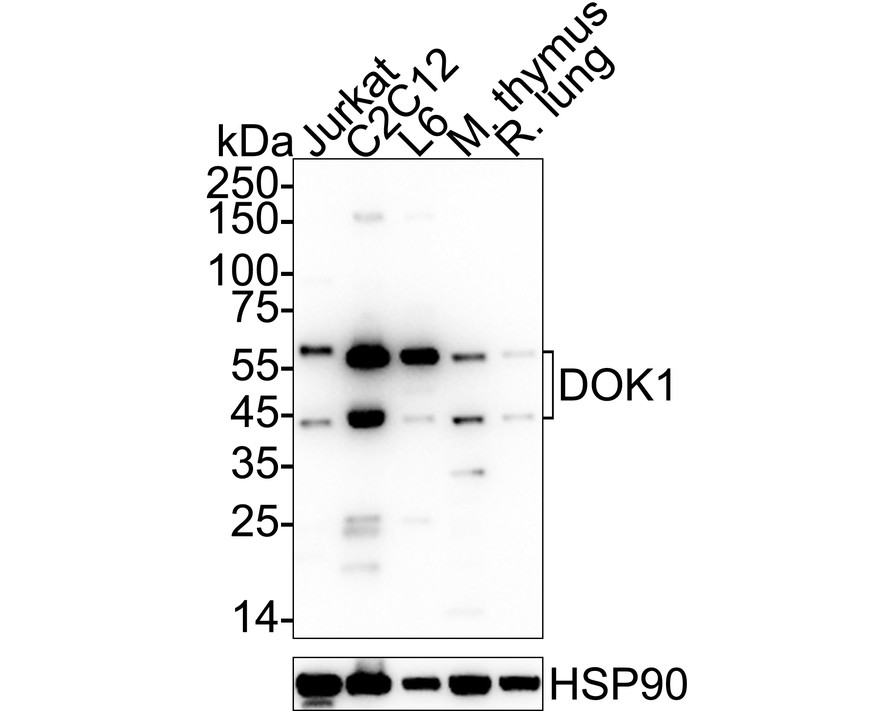
|
Fig1:
Western blot analysis of DOK1 on different lysates with Rabbit anti-DOK1 antibody (ET7110-75) at 1/1,000 dilution. Lane 1: Jurkat cell lysate (20 µg/Lane) Lane 2: C2C12 cell lysate (20 µg/Lane) Lane 3: L6 cell lysate (20 µg/Lane) Lane 4: Mouse thymus tissue lysate (40 µg/Lane) Lane 5: Rat lung tissue lysate (40 µg/Lane) Predicted band size: 52 kDa Observed band size: 44/62 kDa Exposure time: 1 minute 7 seconds; ECL: K1801; 4-20% SDS-PAGE gel. Proteins were transferred to a PVDF membrane and blocked with 5% NFDM/TBST for 1 hour at room temperature. The primary antibody (ET7110-75) at 1/1,000 dilution was used in 5% NFDM/TBST at 4℃ overnight. Goat Anti-Rabbit IgG - HRP Secondary Antibody (HA1001) at 1/50,000 dilution was used for 1 hour at room temperature. |
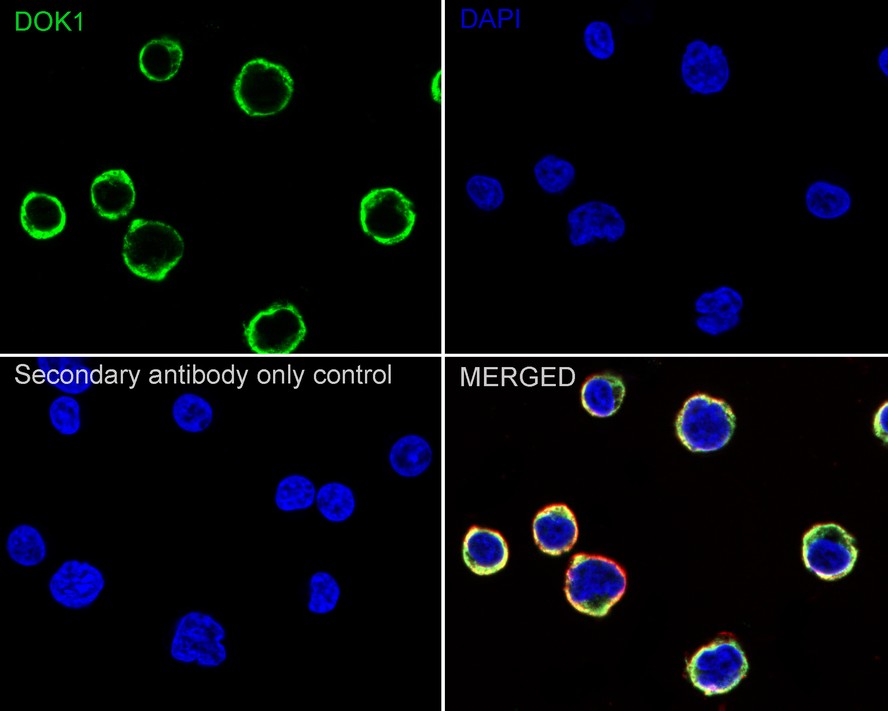
|
Fig2:
Immunocytochemistry analysis of Jurkat cells labeling DOK1 with Rabbit anti-DOK1 antibody (ET7110-75) at 1/100 dilution. Cells were fixed in 4% paraformaldehyde for 15 minutes at room temperature, permeabilized with 0.1% Triton X-100 in PBS for 15 minutes at room temperature, then blocked with 1% BSA in 10% negative goat serum for 1 hour at room temperature. Cells were then incubated with Rabbit anti-DOK1 antibody (ET7110-75) at 1/100 dilution in 1% BSA in PBST overnight at 4 ℃. Goat Anti-Rabbit IgG H&L (iFluor™ 488, HA1121) was used as the secondary antibody at 1/1,000 dilution. PBS instead of the primary antibody was used as the secondary antibody only control. Nuclear DNA was labelled in blue with DAPI. Beta tubulin (HA601187, red) was stained at 1/100 dilution overnight at +4℃. Goat Anti-Mouse IgG H&L (iFluor™ 594, HA1126) was used as the secondary antibody at 1/1,000 dilution. |
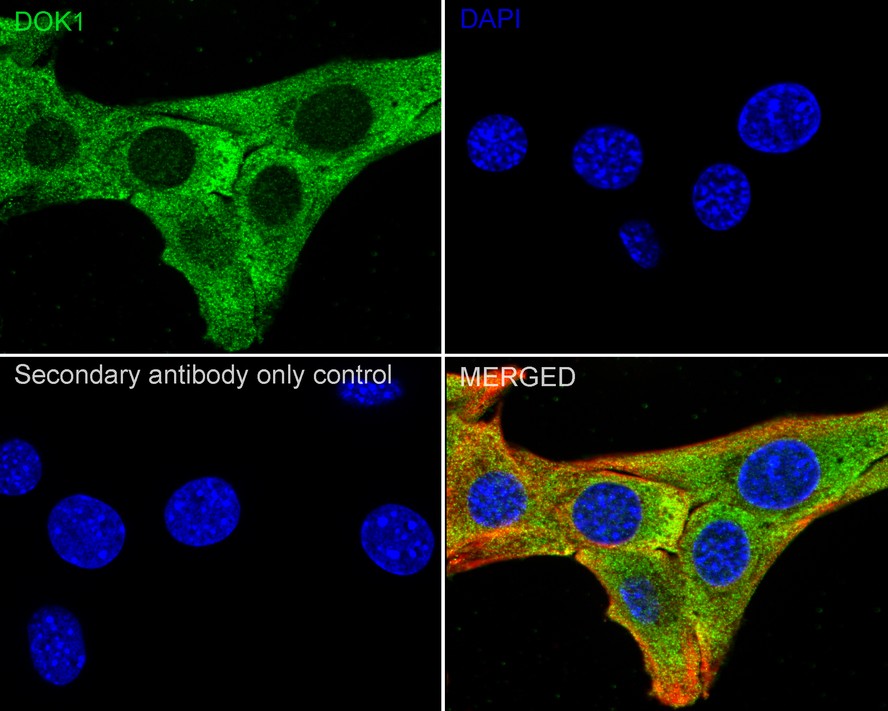
|
Fig3:
Immunocytochemistry analysis of C2C12 cells labeling DOK1 with Rabbit anti-DOK1 antibody (ET7110-75) at 1/100 dilution. Cells were fixed in 4% paraformaldehyde for 15 minutes at room temperature, permeabilized with 0.1% Triton X-100 in PBS for 15 minutes at room temperature, then blocked with 1% BSA in 10% negative goat serum for 1 hour at room temperature. Cells were then incubated with Rabbit anti-DOK1 antibody (ET7110-75) at 1/100 dilution in 1% BSA in PBST overnight at 4 ℃. Goat Anti-Rabbit IgG H&L (iFluor™ 488, HA1121) was used as the secondary antibody at 1/1,000 dilution. PBS instead of the primary antibody was used as the secondary antibody only control. Nuclear DNA was labelled in blue with DAPI. Beta tubulin (HA601187, red) was stained at 1/100 dilution overnight at +4℃. Goat Anti-Mouse IgG H&L (iFluor™ 594, HA1126) was used as the secondary antibody at 1/1,000 dilution. |
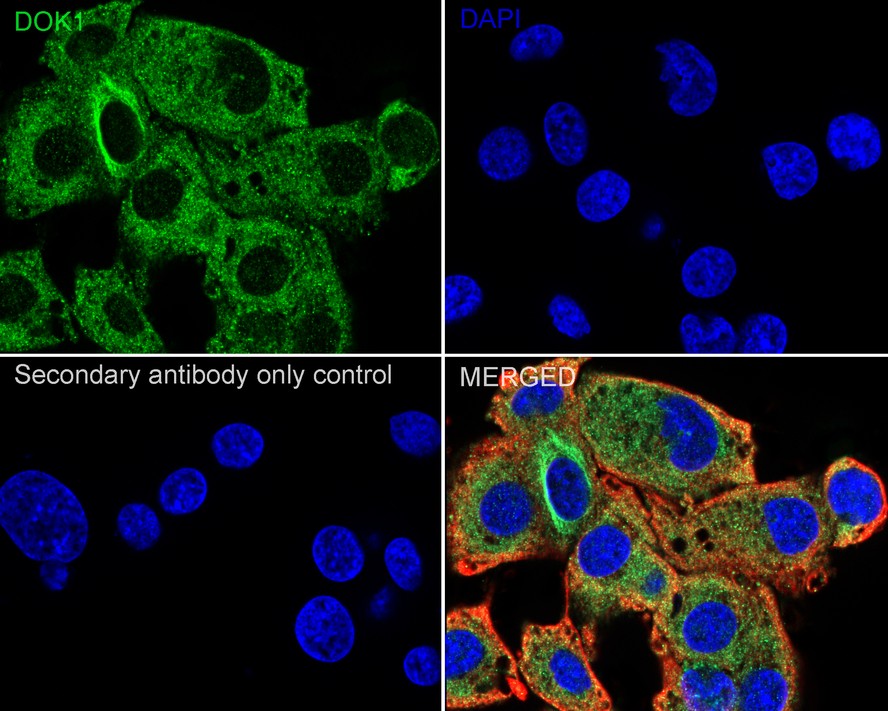
|
Fig4:
Immunocytochemistry analysis of L6 cells labeling DOK1 with Rabbit anti-DOK1 antibody (ET7110-75) at 1/100 dilution. Cells were fixed in 4% paraformaldehyde for 15 minutes at room temperature, permeabilized with 0.1% Triton X-100 in PBS for 15 minutes at room temperature, then blocked with 1% BSA in 10% negative goat serum for 1 hour at room temperature. Cells were then incubated with Rabbit anti-DOK1 antibody (ET7110-75) at 1/100 dilution in 1% BSA in PBST overnight at 4 ℃. Goat Anti-Rabbit IgG H&L (iFluor™ 488, HA1121) was used as the secondary antibody at 1/1,000 dilution. PBS instead of the primary antibody was used as the secondary antibody only control. Nuclear DNA was labelled in blue with DAPI. Beta tubulin (HA601187, red) was stained at 1/100 dilution overnight at +4℃. Goat Anti-Mouse IgG H&L (iFluor™ 594, HA1126) was used as the secondary antibody at 1/1,000 dilution. |
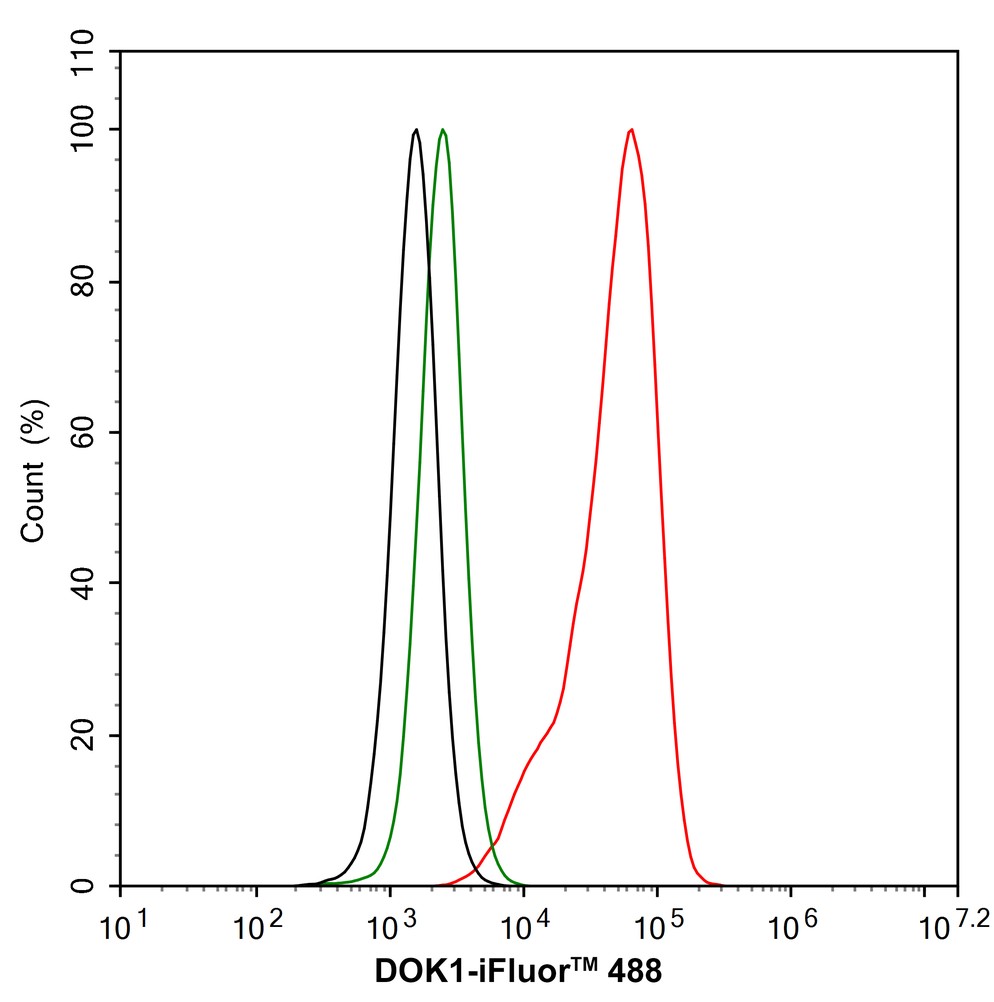
|
Fig5:
Flow cytometric analysis of C2C12 cells labeling DOK1. Cells were fixed and permeabilized. Then stained with the primary antibody (ET7110-75, 1/1,000) (red) compared with Rabbit IgG Isotype Control (green). After incubation of the primary antibody at +4℃ for an hour, the cells were stained with a iFluor™ 488 conjugate-Goat anti-Rabbit IgG Secondary antibody (HA1121) at 1/1,000 dilution for 30 minutes at +4℃. Unlabelled sample was used as a control (cells without incubation with primary antibody; black). |
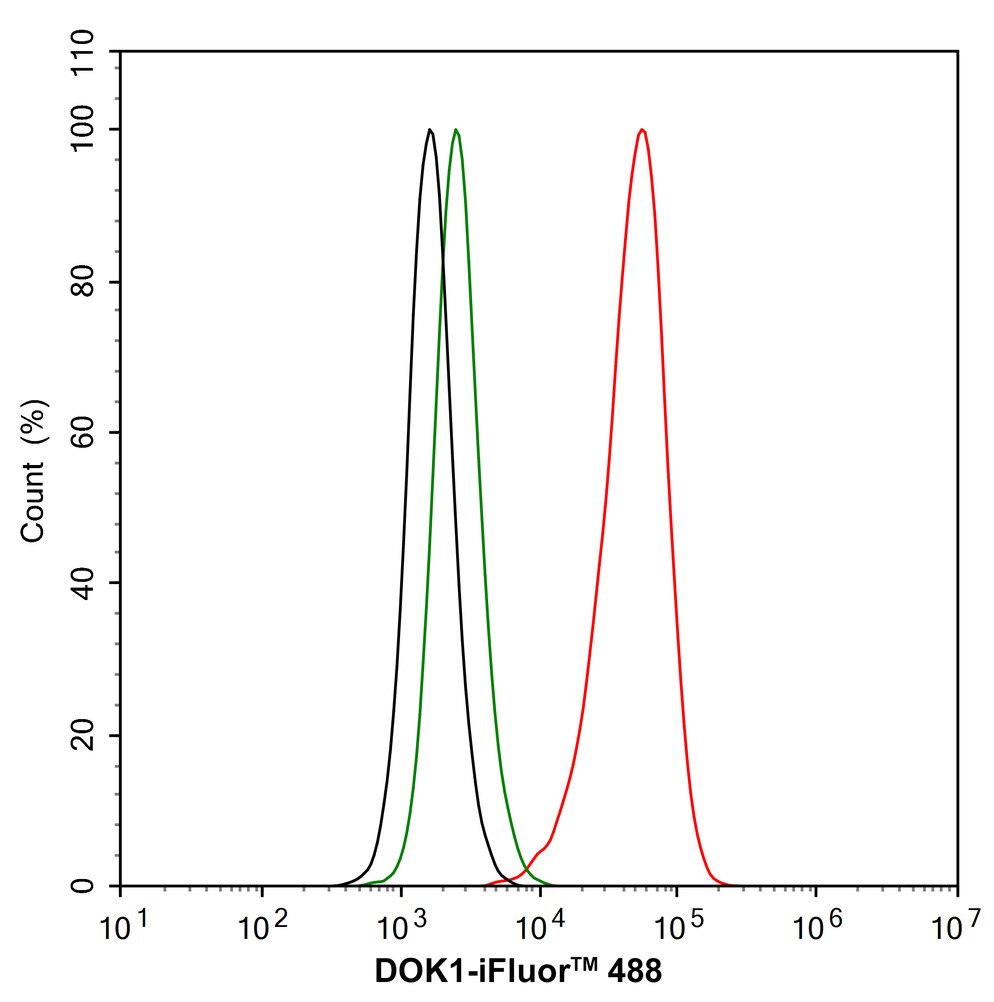
|
Fig6:
Flow cytometric analysis of L6 cells labeling DOK1. Cells were fixed and permeabilized. Then stained with the primary antibody (ET7110-75, 1/1,000) (red) compared with Rabbit IgG Isotype Control (green). After incubation of the primary antibody at +4℃ for an hour, the cells were stained with a iFluor™ 488 conjugate-Goat anti-Rabbit IgG Secondary antibody (HA1121) at 1/1,000 dilution for 30 minutes at +4℃. Unlabelled sample was used as a control (cells without incubation with primary antibody; black). |
Note: All products are “FOR RESEARCH USE ONLY AND ARE NOT INTENDED FOR DIAGNOSTIC OR THERAPEUTIC USE”.